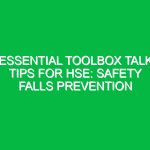Understanding Fall Slip Trip in HSE Context
The term fall slip trip refers to the dangerous incidents that occur when individuals lose their balance, often leading to falls that can cause injuries. In the context of Health, Safety, and Environment (HSE), these incidents are significant because they can result in severe injuries, increased healthcare costs, and even fatalities. With autumn upon us, it’s crucial to recognize the heightened risks associated with this season. Leaves on the ground, wet weather, and changing daylight hours can create hazardous conditions that contribute to slips, trips, and falls.
Why Fall Slip Trip Matters
Injuries from falls are among the leading causes of emergency room visits. According to the National Safety Council, falls accounted for over 8.5 million visits to emergency departments in the United States alone in recent years. The impact of these injuries extends beyond the individual; they can affect workplace productivity, increase insurance premiums, and lead to legal liabilities. Therefore, understanding how to prevent fall slip trip incidents is essential for creating a safer environment, whether in the workplace, at home, or in public spaces.
Common Causes of Fall Slip Trip Incidents
To effectively prevent fall slip trip incidents, it’s essential to be aware of their common causes. Here are several key contributing factors:
- Wet or Slippery Surfaces: Rain, snow, or spills can create slick surfaces that increase the risk of slipping.
- Obstructions: Items left in walkways, such as equipment, cords, or debris, can cause trips.
- Uneven Surfaces: Cracks in pavement, uneven flooring, or changes in elevation can lead to falls.
- Poor Lighting: Inadequate lighting can make it difficult to see Hazards, especially in the early evening as daylight decreases.
- Inappropriate Footwear: Shoes lacking proper traction or support can increase the likelihood of slipping.
Best Practices for Preventing Fall Slip Trip Incidents
Implementing Best Practices is crucial in minimizing the risk of fall slip trip incidents. Here are actionable tips to enhance Safety:
1. Maintain Clean and Dry Surfaces
Regularly inspect and clean walkways and work areas to remove any spills or debris. In wet conditions, use mats or non-slip surfaces to provide traction.
2. Improve Lighting
Ensure that all areas, especially staircases and hallways, are well-lit. Consider motion-sensor lights for outdoor areas that may be used during darker hours.
3. Conduct Regular Inspections
Regularly assess the premises for Hazards, such as uneven surfaces or loose floor tiles. Address any issues immediately to avoid accidents.
4. Use Proper Footwear
Encourage the use of shoes with good grip and support, especially in workplaces where slipping hazards are prevalent.
5. Train Employees and Family Members
Provide Training sessions focused on awareness and Prevention of fall slip trip incidents. Educating individuals about potential hazards can significantly reduce risks.
Real-Life Case Studies: Learning from Experience
Learning from past incidents can provide valuable insights. For instance, in a manufacturing facility in Ohio, an employee slipped on a wet floor after a spill was not promptly cleaned. The resulting injury led to a significant workers’ compensation claim and highlighted the need for better spill management protocols. Following the incident, the company implemented a rigorous cleaning schedule and trained employees on immediate spill reporting.
In another instance, a community center in California experienced multiple slip incidents due to uneven paving stones outside their entrance. The center addressed the issue by leveling the stones and installing handrails, resulting in a marked decrease in fall-related injuries.
Regulations and Standards Related to Fall Slip Trip
Several Regulations govern the prevention of fall slip trip incidents, particularly in workplaces. The Occupational Safety and Health Administration (OSHA) has established standards that require employers to maintain safe working environments. Relevant regulations may include:
- osha Standard 1910.22: General requirements for walking-working surfaces.
- OSHA Standard 1926.501: Fall protection in construction.
- ANSI A1264.2: Standard for the provision of slip resistance in walking surfaces.
These regulations emphasize the importance of maintaining safe surfaces and providing adequate training and protective measures. Failure to comply can result in substantial fines and increased liability for employers.
Conclusion: The Importance of Vigilance in Fall Slip Trip Prevention
In conclusion, preventing fall slip trip incidents is a critical aspect of health, safety, and environmental management. By understanding the causes, implementing Best Practices, and adhering to regulations, individuals and organizations can significantly reduce the risk of falls. As we navigate through the fall season, let us remain vigilant and proactive to ensure our Safety and the safety of those around us. The responsibility lies with each one of us to foster a culture of safety, reducing the likelihood of incidents that can lead to injury or worse.


